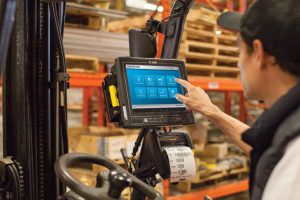 Every industry is impacted by the rapid expansion of IoT solutions, contributing to what’s known as ‘smart workplace’ environments. The warehousing and storage subsector is no exception. Smart warehouses aim to improve their overall quality, productivity, and efficiency with fewer errors. This is done with modern IoT solutions, meaning various devices working remotely across current network infrastructures by automating tasks and engaging human interaction, all to enhance workplace settings and increase profit.
Every industry is impacted by the rapid expansion of IoT solutions, contributing to what’s known as ‘smart workplace’ environments. The warehousing and storage subsector is no exception. Smart warehouses aim to improve their overall quality, productivity, and efficiency with fewer errors. This is done with modern IoT solutions, meaning various devices working remotely across current network infrastructures by automating tasks and engaging human interaction, all to enhance workplace settings and increase profit.
Smart Warehouses – The Basics
The fast growth of IoT solutions creates complex situations (and opportunities) for today’s industrial environments, forcing warehouses to examine the scope of their networks. Smart warehouses merge machinery, mobility, apps, software systems, etc., and depend on connectivity to an enterprise-class network. Thus, the first thing to consider is investing in a next-gen network. This is a network that evolved from stationary fixed and mobile infrastructures to a convergence of networks based on IP. Next-gen networks include advanced access point technology to ensure the strongest possible coverage to unite next-gen IoT solutions. And next-gen networks are mandatory for a smart tech ecosystem to work in harmony, not just as a connected pool for sharing information but also for single device usage. Even tasks not related to a specific revenue-generating activity depend on a reliable network for business to run smoothly.
IoT & Technology – The Heart of Smart Warehouses
Smart warehouses begin with proper IoT deployment. Remember, IoT is the developing collection of all equipment or ‘things’ using the network including mobile phones, tablets, headphones, and wearable gadgets, to name a few. A plethora of IoT-ready wireless workforce tools detect, monitor, and report data as well as receive information and act accordingly. Sensors and actuators are embedded in such devices such as barcode scanners with real-time locating solutions (RTLS) and/or radio frequency identification (RFID) capabilities. Also included are, non-company issued devices and guest devices as well as inbound and outbound logistic tracking tools.
 Machinery & Automation
Machinery & Automation
Modernization of warehouse productivity is led by technology, utilizing sensors and robots to measure and gather data from specific points. A next-gen network is crucial to handle such robust machinery automation. Rather than relying on humans to visually pick and pack an order, automatic picking tools eliminate human error by relying on scans (barcodes or RFID tags) vs. visual identification.
Smart glasses are an ingenious invention allowing employees to work hands-free and ‘see’ visual prompts enabling laborers to work faster with more accuracy. Automatic guided vehicles also remove the human element as they carry out their tasks of moving pallets and racks autonomously. Overall automation lowers failure and downtime improving productivity and security in warehouses.
Software & System Integrations
A Warehouse Management System (WMS) handles the bulk of operations in sophisticated plants today, and connects to all other warehouse systems, providing total visibility at any time. These include comprehensive inventory control measures to assist with orders and inventory management providing real-time information on location, transit, condition, packing, routing, and more. Furthermore, IoT makes a WMS more valuable than ever, filling it with useful data from digital sensors and devices. comprehensive inventory control keeps track of everything in the plant, automatically.
Workforce Management
 IoT solutions help with employee productivity by communicating and collaborating remotely. Examples of direct comms include mobile calls, texts, alerts, emails, push notifications, and warehouse software messaging. Indirect examples are enterprise analytics, data collection procedures, and other push notifications. Other benefits to HR include the ability to see all warehouse operations in real-time as well as the ability to control access for varying management levels.
IoT solutions help with employee productivity by communicating and collaborating remotely. Examples of direct comms include mobile calls, texts, alerts, emails, push notifications, and warehouse software messaging. Indirect examples are enterprise analytics, data collection procedures, and other push notifications. Other benefits to HR include the ability to see all warehouse operations in real-time as well as the ability to control access for varying management levels.
Upgrade to a Next-Gen Network
IoT solutions are making a huge impact on the warehouse business system. More and more types of devices are being network-connected and producing more types of data in smart warehouses. Just remember, smart warehouses and IoT solutions require a high-performance network connection.
Since your network is the lifeblood powering all systems, it’s time to consider an upgrade. Think of your business and how far it’s come in just the last decade, and then consider where you’d like to be as your company advances. With a next-gen network behind all your business goals, consider Extreme Networks. They offer the latest in AI-based and next-gen cloud solutions such as ExtremeWireless, a highly efficient, high-capacity Wi-Fi 6 infrastructure, delivered via world-leading hardware offering increased performance, security, and scalability. Extreme’s innovative approach to networking places them in the ‘Leaders’ box of Gartner’s Magic Quadrant.
